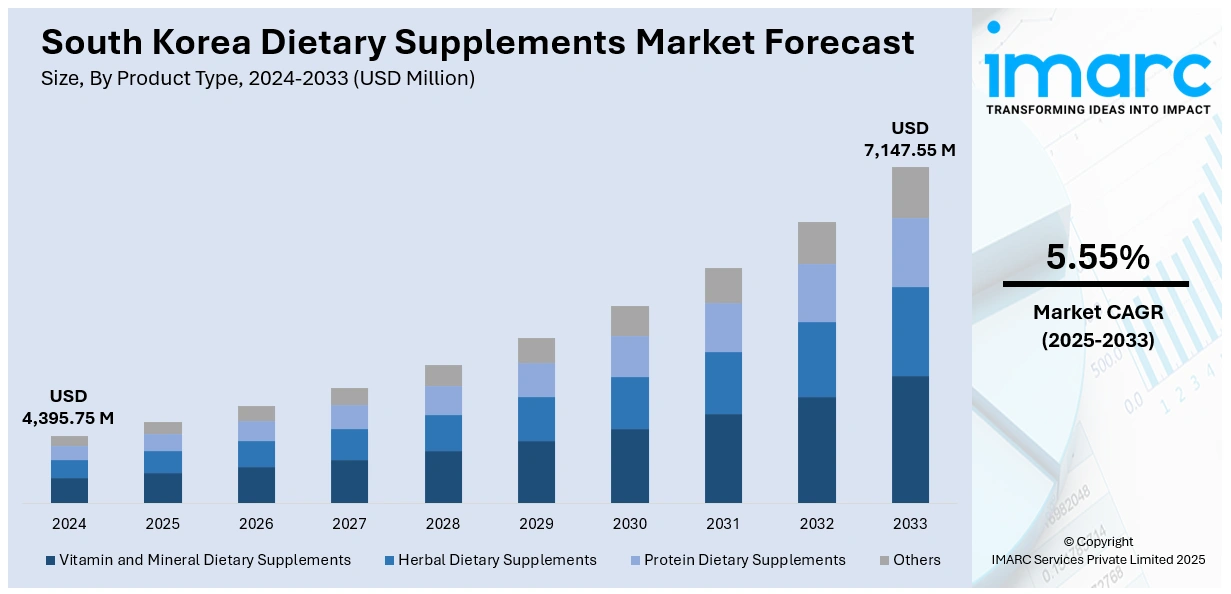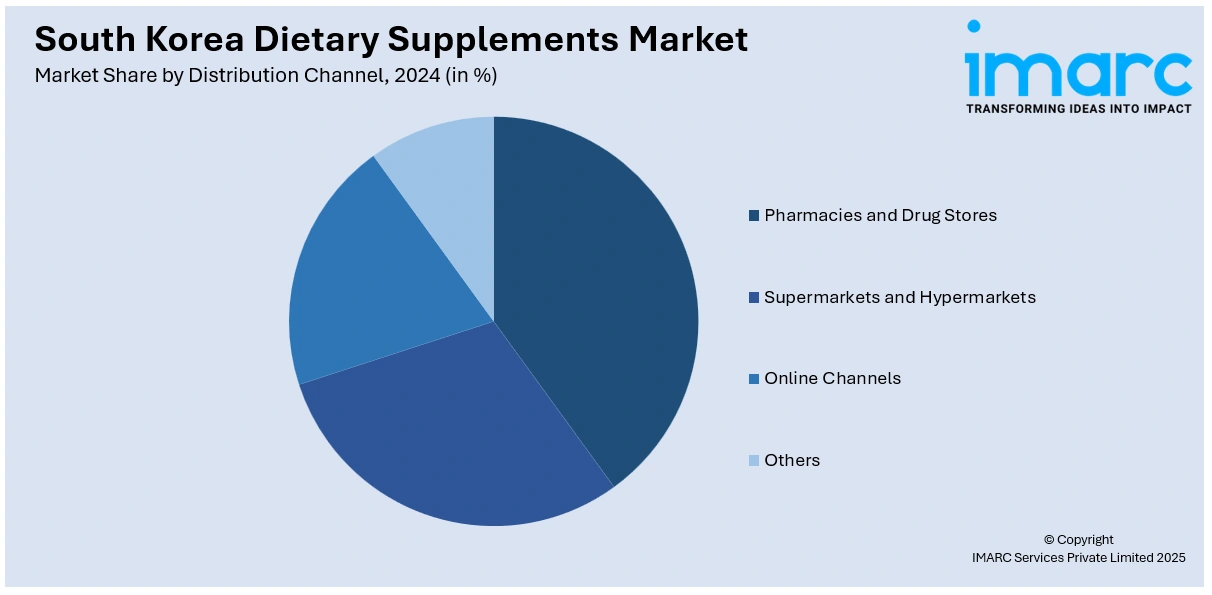
South Korea Dietary Supplements Market Size, Share, Trends and Forecast by Product Type, Form, Distribution Channel, Application, End Use, and Region, 2025-2033
South Korea Dietary Supplements Market Overview:
The South Korea dietary supplements market size reached USD 4,395.75 Million in 2024. Looking forward, IMARC Group expects the market to reach USD 7,147.55 Million by 2033, exhibiting a growth rate (CAGR) of 5.55% during 2025-2033. At present, the growing health consciousness among the country's population is offering a favorable market outlook. Apart from this, the rise in need for products that can assist older adults in maintaining age-related health issues is contributing to the market growth. Furthermore, heightened online shopping activity among the masses is expanding the South Korea dietary supplements market share.
|
Report Attribute
|
Key Statistics
|
|---|---|
|
Base Year
|
2024
|
|
Forecast Years
|
2025-2033
|
|
Historical Years
|
2019-2024
|
| Market Size in 2024 | USD 4,395.75 Million |
| Market Forecast in 2033 | USD 7,147.55 Million |
| Market Growth Rate 2025-2033 | 5.55% |
South Korea Dietary Supplements Market Trends:
Increased Health Consciousness Among Consumers
The market for South Korea's dietary supplements is witnessing significant growth because of the growing health consciousness among the country's population. Consumers are becoming aware about the positive effects of having a healthy life, and this includes complementing their diet with vitamins, minerals, and other substances. This attitude change stems from a growing concern about physical and mental health. Consequently, individuals are consistently looking for supplements to enhance immunity, energy levels, skin function, and general well-being. Preventive healthcare is increasingly gaining attention, with people actively searching for products that act to prevent chronic diseases and preserve their long-term well-being. Brands are countering with a wide variety of products, ranging from multivitamins to specific supplements, thus making it simpler for consumers to fit supplements into their lifestyles. This increased demand is stimulating local and global companies to offer more products in South Korea. In 2025, Pulmuone Green Juice announced its plans to expand its range of Pulmuone Green Juice. Every 130ml bottle contains 340mg (equivalent to two tablets) of corosolic acid derived from Banaba leaf, reportedly "fulfilling 100% of the daily recommended intake" as stated by the Ministry of Food and Drug Safety (MFDS) and aiding in reducing blood sugar spikes post-meals.

To get more information on this market, Request Sample
Aging Population and Growing Chronic Diseases
South Korea's aging population is greatly fueling the South Korea dietary supplements market growth. With an aging population, the need for products that can assist older adults in maintaining age-related health issues is growing. Supplements targeting joint health, bone density, heart health, cognitive function, and overall vitality are gaining attention. Older adults are taking a proactive approach to managing their health, and they are seeking supplements that can enable them to live independently and maintain quality of life. Chronic diseases like hypertension, diabetes, and osteoarthritis are common, and supplements are being touted as solutions to help reduce the symptoms of these diseases. The healthcare system of the country also promotes this trend by inspiring people to utilize supplements as part of a comprehensive health maintenance plan, hence increasing the demand for such products.
Increased E-commerce and Online Availability
Online shopping convenience is fast revolutionizing South Korea's market for dietary supplements. With online platforms growing, consumers are making more purchases of supplements from e-commerce platforms and mobile applications. Increased digitalization and growing online shopping culture have enabled people to get easy access to various dietary supplements sitting at home. Furthermore, consumers are utilizing online media to comparison shop, read reviews, and learn about new products. Health-oriented online forums and social media influencers are also increasingly influencing consumer preferences and making purchasing decisions. With Naver, Kakao, and Coupang becoming indispensable for product discovery, supplement brands are investing in a stronger web presence to engage this digitally savvy customer base.
South Korea Dietary Supplements Market Segmentation:
IMARC Group provides an analysis of the key trends in each segment of the market, along with forecasts at the country and regional levels for 2025-2033. Our report has categorized the market based on product type, form, distribution channel, application, and end use.
Product Type Insights:
- Vitamin and Mineral Dietary Supplements
- Herbal Dietary Supplements
- Protein Dietary Supplements
- Others
The report has provided a detailed breakup and analysis of the market based on the product type. This includes vitamin and mineral dietary supplements, herbal dietary supplements, protein dietary supplements, and others.
Form Insights:
- Tablets
- Capsules
- Powders
- Liquids
- Soft Gels
- Gel Caps
A detailed breakup and analysis of the market based on the form have also been provided in the report. This includes tablets, capsules, powders, liquids, soft gels, and gel caps.
Distribution Channel Insights:

- Pharmacies and Drug Stores
- Supermarkets and Hypermarkets
- Online Channels
- Others
A detailed breakup and analysis of the market based on the distribution channel have also been provided in the report. This includes pharmacies and drug stores, supermarkets and hypermarkets online channels, and others.
Application Insights:
- Additional Supplements
- Medicinal Supplement
- Sports Nutrition
A detailed breakup and analysis of the market based on the application have also been provided in the report. This includes additional supplements, medicinal supplements, and sports nutrition.
End Use Insights:
- Infant
- Children
- Adults
- Pregnant Women
- Old-Aged
A detailed breakup and analysis of the market based on the end use have also been provided in the report. This includes infant, children, adults, pregnant women, and old-aged.
Regional Insights:
- Seoul Capital Area
- Yeongnam (Southeastern Region)
- Honam (Southwestern Region)
- Hoseo (Central Region)
- Others
The report has also provided a comprehensive analysis of all the major regional markets, which include Seoul Capital Area, Yeongnam (Southeastern Region), Honam (Southwestern Region), Hoseo (Central Region), and others.
Competitive Landscape:
The market research report has also provided a comprehensive analysis of the competitive landscape. Competitive analysis such as market structure, key player positioning, top winning strategies, competitive dashboard, and company evaluation quadrant has been covered in the report. Also, detailed profiles of all major companies have been provided.
South Korea Dietary Supplements Market Report Coverage:
| Report Features | Details |
|---|---|
| Base Year of the Analysis | 2024 |
| Historical Period | 2019-2024 |
| Forecast Period | 2025-2033 |
| Units | Million USD |
| Scope of the Report |
Exploration of Historical Trends and Market Outlook, Industry Catalysts and Challenges, Segment-Wise Historical and Future Market Assessment:
|
| Product Types Covered | Vitamin and Mineral Dietary Supplements, Herbal Dietary Supplements, Protein Dietary Supplements, Others |
| Forms Covered | Tablets, Capsules, Powders, Liquids, Soft Gels, Gel Caps |
| Distribution Channels Covered | Pharmacies and Drug Stores, Supermarkets and Hypermarkets, Online Channels, Others |
| Applications Covered | Additional Supplements, Medicinal Supplement, Sports Nutrition |
| End Uses Covered | Infant, Children, Adults, Pregnant Women, Old-Aged |
| Regions Covered | Seoul Capital Area, Yeongnam (Southeastern Region), Honam (Southwestern Region), Hoseo (Central Region), Others |
| Customization Scope | 10% Free Customization |
| Post-Sale Analyst Support | 10-12 Weeks |
| Delivery Format | PDF and Excel through Email (We can also provide the editable version of the report in PPT/Word format on special request) |
Key Questions Answered in This Report:
- How has the South Korea dietary supplements market performed so far and how will it perform in the coming years?
- What is the breakup of the South Korea dietary supplements market on the basis of product type?
- What is the breakup of the South Korea dietary supplements market on the basis of form?
- What is the breakup of the South Korea dietary supplements market on the basis of distribution channel?
- What is the breakup of the South Korea dietary supplements market on the basis of application?
- What is the breakup of the South Korea dietary supplements market on the basis of end use?
- What is the breakup of the South Korea dietary supplements market on the basis of region?
- What are the various stages in the value chain of the South Korea dietary supplements market?
- What are the key driving factors and challenges in the South Korea dietary supplements market?
- What is the structure of the South Korea dietary supplements market and who are the key players?
- What is the degree of competition in the South Korea dietary supplements market?
Key Benefits for Stakeholders:
- IMARC’s industry report offers a comprehensive quantitative analysis of various market segments, historical and current market trends, market forecasts, and dynamics of the South Korea dietary supplements market from 2019-2033.
- The research report provides the latest information on the market drivers, challenges, and opportunities in the South Korea dietary supplements market.
- Porter's five forces analysis assist stakeholders in assessing the impact of new entrants, competitive rivalry, supplier power, buyer power, and the threat of substitution. It helps stakeholders to analyze the level of competition within the South Korea dietary supplements industry and its attractiveness.
- Competitive landscape allows stakeholders to understand their competitive environment and provides an insight into the current positions of key players in the market.
Need more help?
- Speak to our experienced analysts for insights on the current market scenarios.
- Include additional segments and countries to customize the report as per your requirement.
- Gain an unparalleled competitive advantage in your domain by understanding how to utilize the report and positively impacting your operations and revenue.
- For further assistance, please connect with our analysts.
 Request Customization
Request Customization
 Speak to an Analyst
Speak to an Analyst
 Request Brochure
Request Brochure
 Inquire Before Buying
Inquire Before Buying




.webp)




.webp)












